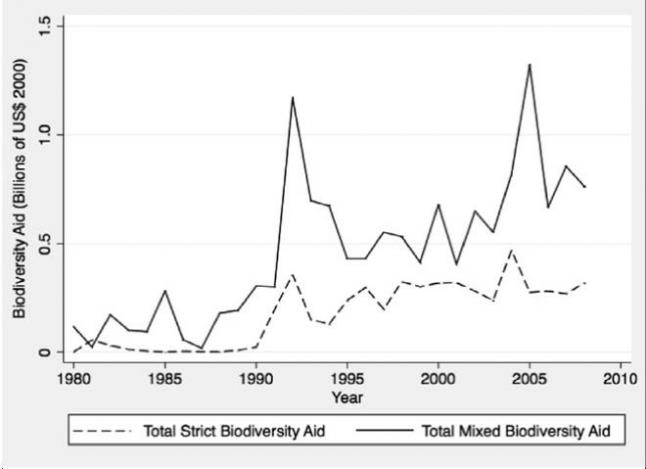In a forthcoming World Development article entitled “Explaining Global Patterns of International Aid for Linked Biodiversity Conservation and Development,” Dan Miller of the University of Michigan analyzed the distribution of biodiversity-related aid across time and geographic space. Miller used the AidData database to collect information on biodiversity aid projects around the world between 1980 and 2008. His study moves beyond identification of biodiversity aid in the aggregate to examine flows of two important types of biodiversity-related aid: “strict” biodiversity aid that focuses only on conservation and “mixed” biodiversity aid that explicitly blends conservation and development objectives. Miller’s findings suggest that three central factors influence the kind of biodiversity aid a recipient country receives.
1. The biodiversity and development needs of the recipient country.The biodiversity importance of recipient countries was positively associated with both types of biodiversity aid, although the correlation was somewhat stronger for strict aid. The study also found that poorer, more populous countries received more mixed aid than strict aid, suggesting donor selectivity in allocating the two types of biodiversity aid.
2. Quality of governance in a recipient country.The quality of a recipient country’s governance was correlated with the receipt of both strict and mixed biodiversity aid. However, the association was stronger for mixed aid suggesting a donor preference for funding mixed projects, which are complex and may require a long time commitment in more open, stable governance contexts.
3. The economic and political leverage a recipient bears on donors.The distribution of mixed biodiversity aid was tilted towards countries with relatively long histories of political independence. This suggests that more powerful states are able to induce donors to provide biodiversity aid that is more likely to deliver rather than limit economic development opportunities for their citizens.

Distribution of strict biodiversity aid as a proportion of total biodiversity aid received during the period 1980-2008. Countries in lighter purple shades received greater amounts of mixed conservation and development aid than countries in the darker purple. Countries in grey received no biodiversity aid during the study period.
The data shows that biodiversity aid has increased substantially since 1980, particularly during the early 1990s. While mixed projects were less numerous than strict projects, on average they were roughly three times larger and comprised 72 percent of total donor dollars. The proportion of mixed to strict aid remained the same during 2000-2008 as during 1991-1999, despite the increasing emphasis in international development policy discourse on poverty since 2000. Spikes in aid flows occurred around specific events that mark increased commitment to environmental aid, such as the Rio Summit in 1992.

Distribution of two kinds of biodiversity aid during the period 1980-2008.
Miller’s research also shows that bilateral aid has tended to support strict conservation projects while multilateral aid generally oriented towards mixed biodiversity projects. One potential explanation for this pattern is that bilateral donor governments are responding to environmentally-minded constituents who are concerned with biodiversity as a global public good, while multilateral donors have greater budgets and flexibility to undertake larger, more complex projects that blend development and conservation objectives.
This study fills a critical knowledge gap regarding how aid with a biodiversity conservation focus is allocated across countries and time. However, there is still a great deal that we do not know. In particular, we still lack a strong body of evidence about the relative effectiveness of the two kinds of biodiversity aid. Do strict aid projects better deliver biodiversity goals or can aid projects effectively protect biodiversity while also benefitting local people? Stay tuned for future blog posts on The First Tranche on this important policy issue.
